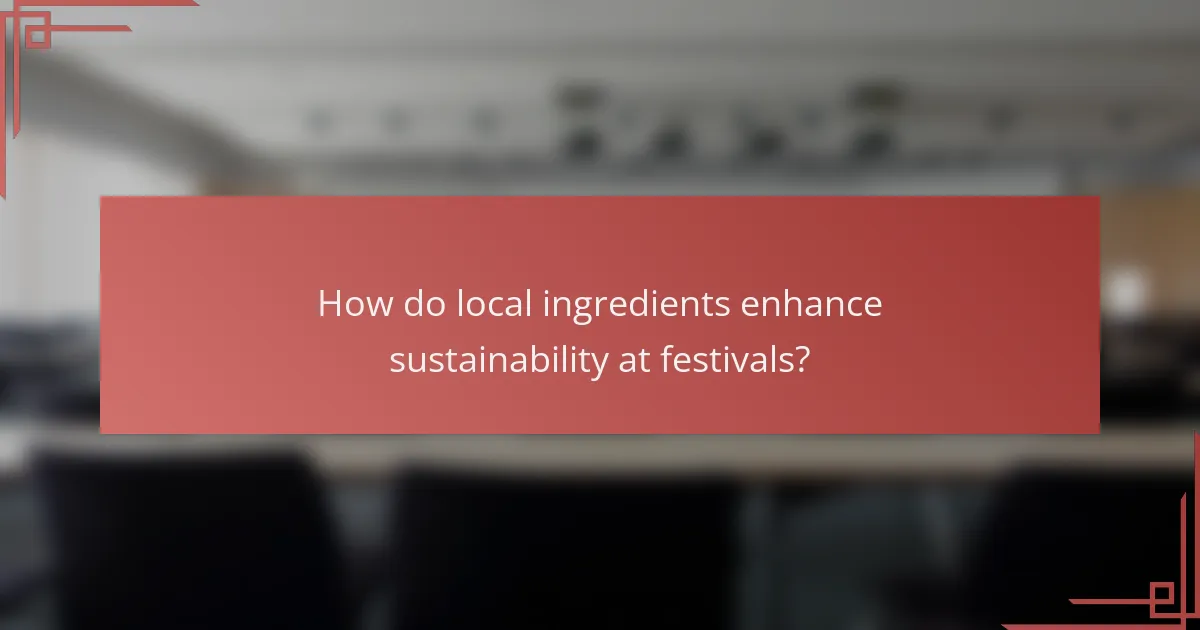Local ingredients play a crucial role in enhancing sustainability at festivals by lowering transportation emissions and bolstering regional economies. By prioritizing food sourced from nearby farms, festivals not only minimize their carbon footprint but also foster community connections and reduce food waste. Embracing best practices such as partnering with local suppliers and utilizing seasonal produce can significantly amplify these benefits.

How do local ingredients enhance sustainability at festivals?
Local ingredients significantly enhance sustainability at festivals by reducing transportation emissions, supporting regional economies, and minimizing food waste. By sourcing food from nearby farms and producers, festivals can create a more environmentally friendly and community-oriented event.
Reduced carbon footprint
Using local ingredients lowers the carbon footprint associated with food transportation. When food is sourced from nearby farms, the distance it travels is significantly reduced, leading to lower greenhouse gas emissions. For instance, ingredients that travel less than 100 kilometers can cut transport-related emissions by up to 50% compared to those shipped from hundreds of kilometers away.
Festivals can further enhance this benefit by partnering with local suppliers and promoting their use in marketing materials. This not only raises awareness but also encourages attendees to consider the environmental impact of their food choices.
Support for local economies
Sourcing local ingredients supports regional economies by keeping money within the community. When festivals purchase from local farmers and producers, they help sustain jobs and promote agricultural practices that are often more sustainable. This creates a positive economic cycle that benefits both the festival and the local community.
Moreover, festivals can showcase local businesses through vendor partnerships, which can lead to increased visibility and sales for these producers. This collaboration fosters a sense of community and encourages attendees to support local enterprises beyond the event.
Minimized food waste
Utilizing local ingredients can significantly reduce food waste at festivals. When food is sourced nearby, it can be harvested closer to the event date, ensuring freshness and reducing spoilage. Festivals can also plan menus based on seasonal availability, which helps in accurately estimating food needs and minimizing excess.
Additionally, festivals can implement strategies such as composting or donating leftover food to local shelters, further reducing waste. Engaging attendees in these initiatives can enhance their awareness of food sustainability practices.
Freshness and quality
Local ingredients often provide superior freshness and quality compared to those transported over long distances. Fresh produce not only tastes better but also retains more nutrients, enhancing the overall dining experience at festivals. Attendees are more likely to appreciate and enjoy meals made from high-quality, locally sourced ingredients.
Festivals can highlight these benefits by featuring local chefs who create dishes that showcase the flavors of the region. This not only elevates the culinary experience but also reinforces the importance of local sourcing.
Community engagement
Incorporating local ingredients fosters community engagement by connecting festival-goers with local producers and farmers. This interaction can take the form of workshops, tastings, or farm tours, creating a deeper appreciation for the food and its origins. Such activities can enhance the festival experience and promote a culture of sustainability.
Moreover, festivals can encourage attendees to participate in discussions about local food systems and sustainability practices. This engagement can lead to lasting changes in consumer behavior, encouraging a shift towards supporting local agriculture beyond the festival setting.

What are the best practices for sourcing local ingredients?
Best practices for sourcing local ingredients include forming partnerships with nearby farms, utilizing seasonal produce, and engaging local suppliers. These strategies not only support local economies but also reduce the carbon footprint associated with transporting food over long distances.
Partnering with local farms
Collaborating with local farms allows festivals to access fresh ingredients while supporting the community. Establishing direct relationships can lead to better pricing and quality, as well as opportunities for unique, locally-sourced menu items. Consider visiting farms to understand their practices and ensure they align with your sustainability goals.
When partnering, aim for farms that practice sustainable agriculture, which can include organic methods or regenerative practices. This not only enhances the quality of the ingredients but also promotes environmental health.
Utilizing seasonal produce
Using seasonal produce is crucial for maximizing flavor and minimizing environmental impact. Ingredients that are in season are typically fresher, more nutritious, and less expensive due to their abundance. Festivals should plan menus around what is locally available during the event dates.
To effectively utilize seasonal produce, create a calendar that outlines peak seasons for various fruits and vegetables in your region. This can help in menu planning and ensure that you are sourcing ingredients at their best.
Engaging local suppliers
Engaging local suppliers can streamline the sourcing process and enhance the festival’s sustainability efforts. Local suppliers often have a better understanding of the regional market and can provide insights into available products and pricing. This can lead to more efficient procurement and reduced transportation emissions.
When selecting suppliers, prioritize those who share your commitment to sustainability. Look for certifications or practices that demonstrate their dedication to environmentally friendly operations. Establishing long-term relationships can also foster collaboration and innovation in sourcing practices.

Which festivals prioritize local ingredients for sustainability?
Several festivals focus on using local ingredients to enhance sustainability, reducing carbon footprints and supporting regional economies. These events often feature local farmers and producers, showcasing the benefits of fresh, seasonal produce.
Farm-to-Fork Festival
The Farm-to-Fork Festival emphasizes direct connections between local farmers and consumers. This festival typically features a variety of food vendors who source their ingredients from nearby farms, promoting seasonal eating and reducing transportation emissions.
Attendees can expect to enjoy dishes made from fresh, locally sourced ingredients, often accompanied by educational workshops on sustainable farming practices. This festival not only supports local agriculture but also fosters community engagement.
Green Festival
The Green Festival is dedicated to promoting eco-friendly practices, including the use of local ingredients. This event showcases vendors who prioritize sustainable sourcing and environmentally responsible production methods.
Visitors can explore a range of organic and locally produced food options, along with workshops on sustainable living. By supporting local businesses, the Green Festival helps to minimize environmental impact while encouraging a healthier lifestyle.
Eat Drink Local Festival
The Eat Drink Local Festival celebrates regional cuisine by featuring chefs and restaurants that use ingredients sourced from local farms. This festival highlights the importance of eating seasonally and supports the local economy.
Attendees can sample a variety of dishes and beverages made from fresh, local produce, often accompanied by cooking demonstrations and discussions on the benefits of local sourcing. This event fosters a deeper appreciation for local food systems and sustainable practices.

What are the challenges of using local ingredients at festivals?
Using local ingredients at festivals can present several challenges, including supply chain limitations, seasonal availability, and higher costs. These factors can affect the feasibility and sustainability of sourcing food locally for large events.
Supply chain limitations
Local ingredients often rely on a limited supply chain, which can be disrupted by various factors such as weather conditions or transportation issues. For festivals, this means that vendors may struggle to secure enough produce or products to meet demand, especially during peak times.
To mitigate these challenges, festival organizers should establish strong relationships with local farmers and suppliers well in advance. This proactive approach can help ensure a more reliable supply of ingredients and reduce the risk of shortages.
Seasonal availability
Seasonal availability is a significant challenge when using local ingredients, as many fruits and vegetables have specific growing seasons. For instance, tomatoes may only be available in the summer months, while root vegetables are typically harvested in the fall.
Festival planners should consider the timing of their events and plan menus that align with the local harvest calendar. This can enhance the freshness of the food served and support local agriculture.
Higher costs
Local ingredients can sometimes be more expensive than imported options due to limited production scales and higher transportation costs. This can lead to increased menu prices, which may deter some festival-goers.
To address higher costs, organizers might explore partnerships with local farms for bulk purchasing or consider offering a smaller selection of local dishes that highlight seasonal ingredients. This can help balance quality and affordability while promoting local sourcing.

How can festivals measure the impact of local ingredient sourcing?
Festivals can measure the impact of local ingredient sourcing by evaluating various sustainability metrics, including carbon footprint, waste generation, and community economic benefits. These assessments help organizers understand the environmental and social implications of their sourcing decisions.
Carbon footprint analysis
Carbon footprint analysis involves calculating the total greenhouse gas emissions associated with sourcing ingredients locally versus from distant suppliers. This includes transportation emissions, energy use in food preparation, and waste management. By comparing these figures, festivals can gauge the environmental benefits of local sourcing.
To conduct a carbon footprint analysis, festivals should gather data on transportation distances, types of vehicles used, and the energy consumption of cooking methods. Tools such as carbon calculators can simplify this process, allowing organizers to estimate emissions in terms of CO2 equivalents.
For example, sourcing ingredients from within a 100-kilometer radius may significantly reduce emissions compared to sourcing from over 1,000 kilometers away. Establishing partnerships with local farms can further enhance sustainability while fostering community relationships.



